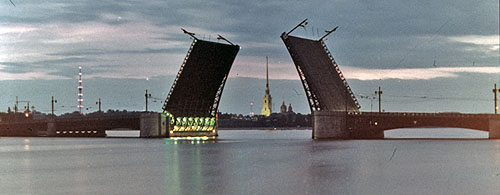Unit 15: Whither Russia in the Twentieth Century?

This is an image of the modern Razvodnoi Most in St. Petersburg. In the late imperial regime, St. Petersburg was filled with draw bridges--after all it was called the "Venice of the North." It was common practice for the police/authorities to raise the draw bridges at the slightest sign of trouble to try and keep the workers quarters of the city isolated. But you know, it was impossible to keep the workers contained forever.
- Review all of the applicable chapters in the textbook since the midterm exam.
- Check the remarks by Professor Blois and Professor Evans on the fate of imperial Russia.
- If you have not done so already, now would be a good time to review my interactive lecture on Russian geography.
- Study the Questions to Consider and the Key Terms for the Unit.
- Take the final exam.
- Post (or respond) your thoughts/ideas about this Unit's reading and assignment in the Blackboard online discussion forum. Do not post your assignment there.
- For extra credit please suggest to your instructor a relevant video for this unit of the course. Send the title of the video, the url and a brief explanation of why you find the video interesting and applicable to the material that is being studied in this unit.
- For 50 points maximum extra credit, dare to watch Russkii Kovcheg (Russian Ark, 2002)--Don't look at my comments on the film before you watch it--and write a one-page paper explaining the film's presentation of Russian history.
- For extra credit, please suggest a relevant website for this unit of the course. Send the title of the site, the url and a brief explanation why you find the information interesting and applicable to the material being studied this Unit.
- Suggest an assignment for use somewhere in the course. Be creative!
- For extra credit of a maximum of 10 points, write a short paragraph in which you explain what you found most interesting about your study of Russian history in HIS 241 (or what you liked most about the course).